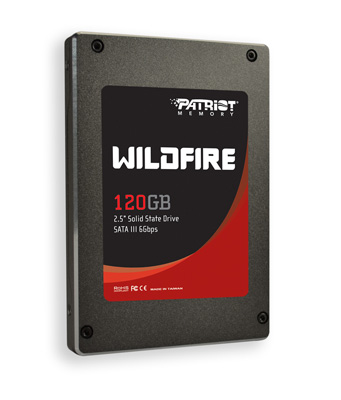OCZ Vertex 3 MAX IOPS & Patriot Wildfire SSDs Reviewed
by Anand Lal Shimpi on June 23, 2011 4:35 AM ESTPatriot's Wildfire
OCZ isn't the only company experimenting with SF-2281 drives and 32nm NAND. Patriot sent me the Wildfire, its first SF-2281 SSD. After a quick run through some performance tests I grew suspicious as it performed a lot like the Vertex 3 MAX IOPS I just tested. Cracking open the case I found the reason:
The Wildfire also uses 32nm Toshiba NAND. The 120GB drive Patriot sent has a 16 chip, 2 die per package configuration - compared to 8 chips with 4 die per package in the Vertex 3 MI. I don't see an advantage for one approach vs. the other. Patriot is targeting a $299 MSRP for the Wildfire, which would put it lower than the Vertex 3 MAX IOPS - although anything is possible once the drive goes on sale on the 28th of this month.

Patriot confirmed that the Wildfire would only use 32nm Toshiba NAND and that any NAND vendor changes would take place in other lines or subsets of the Wildfire brand.
Patriot uses a different PCB layout from OCZ. I don't know that there's an advantage to either layout, they are just different.
The unit I have here shipped with SF firmware revision 3.19, which is equivalent to OCZ's revision 2.08 firmware as far as I know. No word on when we'll see a 2.09 equivalent.
Performance of the Wildfire (as you'll see from the tests that follow) is identical to the Vertex 3 MAX IOPS. To keep the charts more manageable I've only included 6Gbps results from the Wildfire in most areas. Performance on a 3Gbps interface is identical to a 3Gbps Vertex 3 MAX IOPS as you'd expect.
The Test
| CPU | Intel Core i7 965 running at 3.2GHz (Turbo & EIST Disabled) Intel Core i7 2600K running at 3.4GHz (Turbo & EIST Disabled) - for AT SB 2011, AS SSD & ATTO |
| Motherboard: | Intel DX58SO (Intel X58) Intel H67 Motherboard |
| Chipset: | Intel X58 + Marvell SATA 6Gbps PCIe Intel H67 |
| Chipset Drivers: | Intel 9.1.1.1015 + Intel IMSM 8.9 Intel 9.1.1.1015 + Intel RST 10.2 |
| Memory: | Qimonda DDR3-1333 4 x 1GB (7-7-7-20) |
| Video Card: | eVGA GeForce GTX 285 |
| Video Drivers: | NVIDIA ForceWare 190.38 64-bit |
| Desktop Resolution: | 1920 x 1200 |
| OS: | Windows 7 x64 |












112 Comments
View All Comments
GullLars - Thursday, June 23, 2011 - link
I noticed the clear winner at your 4KB random read (QD3) test has been cleared from the chart. The C300 pushes over 90MB/s while the second highest, and the highest in this cart, is Vertex 3 240GB with 68MB/s. I feel this is worth noting, as the SF-2281 drives generally win with a good margin in many tests, but loose to a more than year old drive in small random reads at low queue depths.Bannon - Thursday, June 23, 2011 - link
Thanks for another good review Anand. I've been following the discussions in the Corsair and OCZ forums and while I'm interested in the super-fast speeds of the new SandForce drives I'm leery because of the problems a percentage of their customers are having. So, I was considering a 256GB Crucial M4 drive which seemed to do well in your review but was surprised when you recommended the Intel 510 drive as an alternative. Do you have concerns with the M4?ocz2004 - Thursday, June 23, 2011 - link
Hello everyone, as my first post in this thread let me identify myself as an OCZ employee. I’d like to thank everyone for their comments. Positive or negative, we appreciate all the feedback and take it very seriously throughout the organization. We continue to see a very small percentage of users with the BSOD issue but have made addressing this a high priority, and encourage any customers that have this or any issues to contact our customer service team. We have and will continue to work closely with SandForce and our platform partners for a final fix, and have spearheaded this effort among all manufacturers that utilize a SF solution. As mentioned in our previous public statement, we are also working on optimizations to the base code to minimize any performance delta associated with the temporary workaround. Thank everyone again for your support and feedback, and we will continue to work diligently on providing both premium performing and reliable SSDs to all our valued customers. We are willing to go above and beyond to make our customers happy; for anyone that is having this issue please contact support at drego @ ocz dot comtecsi - Thursday, June 23, 2011 - link
From Anand's comments:"It turns out that although the move from a hard drive to a decent SSD is tremendous, finding differences between individual SSDs is harder to quantify in a single real world metric...The best values in SSDs are going to be last year's models without a doubt."
It appears that the best desktop SSD value--by far--is grabbing a 64GB SATA II boot/app drive (paired with a big HD), which are often rebated to ~$70. Although SATA III and 120GB/240GB look great on a specialized SSD racetrack, in the real world the performance difference appears to be a 5-10%, while paying just 30% of the $250 cost for a SATA III 120GB drive.
Does this make sense or am I missing something? I was getting quite excited about SATA III and all the fawning over the Vertex 3, but this enthusiasm seems misplaced.
Impulses - Thursday, June 23, 2011 - link
Only issue with that is that after formatting and installing the OS, a 64GB SSD doesn't leave you a lot of extra space... Depending on your needs that may or may not be an issue. I got an 80GB Intel X25-M for my desktop last year and it's a little tight, I have the luxury of having enough space for a couple of games but I do rotate which ones I have on it... I'm looking at 120GB drives but I'm waiting for prices to come down a little.I got a 40GB X25-V for my netbook tho and it's just for that kinda system... Win7 and the basic kind of programs that I use on my netbook all fit fine within <25GB, and with only 1.5GB of RAM the size of the hibernate file isn't a big concern. Still got enough space for a couple of movies when I travel.
FunBunny2 - Thursday, June 23, 2011 - link
Over on Postgresql-performance, for one, there is not much love for anything less than full blown cap-backed SSDs, and even then, when used for database logs (not necessarily a good use of an SSD) 18 months is about the lifetime.So, using highly normalized (BCNF, which you shouldn't have to look up) X00 gig databases only on SSD (no HDD for logs and such) is a real torture test. Random access in a real world application. Oracle and MS have them. TPC, of course, has a bunch.
jdmstl - Thursday, June 23, 2011 - link
I had a problem with the Vertex 3 240GB in a new Thinkpad W520. The bluescreen occurred at relatively light or idle usage, but seemed to have nothing to do with power save features. I tried disabling all such features in the bios, as well as a number of logical software fixes to no avail.Finally, I simply returned the drive to Microcenter for a refund rather than deal with the issues. I never posted my problems to OCZ, although I read the related forum posts for clues.
I suspect that many people did the same, so I would not trust any defect rate figures based on number of forum posts. It would be more accurate to check the return rate, but I suspect that many people just ignore the BSODs and live with it without reporting any issue, assuming it will all work out eventually.
OCZ tries to deny or downplay issues without taking full responsibility. They did the same thing with JMicron controller problems a few years ago. (Not that any other brands were more honest or forthcoming.)
I think I will stick with Intel from now on, although I had good luck with 4 of the original Vertex Indilinx drives that are still running fine in my home desktop PCs.
jwilliams4200 - Friday, June 24, 2011 - link
OCZ is definitely the leader when it comes to their propaganda machine. It seems even Anand has gotten brainwashed by it.Concillian - Friday, June 24, 2011 - link
It really helps to read that page to put the performance picture in perspective. This kind of thing is difficult to get a feel for when looking at reviews.It's easy to tell which is faster from benchmarks, but it's not always easy to tell how much that speed will translate into actual perceivable improvement for daily workloads.
I think you should throw in a few "vs. rotating storage" charts in every SSD review just to help demonstrate the performance differences to those contemplating the jump to SSD. Many of your readers have made the jump and are looking at SSDs vs. SSDs, but I'll bet a fair amount are still looking at the value vs. a hard drive and haven't necessarily seen the history of all the articles that show these differences.
cactusdog - Friday, June 24, 2011 - link
I respect Anands opinions but the timing of his reviews and comments(regarding OCZ) makes it seem he is working with OCZ. Like he wont say anything negative unless OCZ have already addressed it.Its strange this review hit just after the new firmware 2.09 was released. The 2.09 firmware that is supposed to fix any BSOD issues.
Going back over previous reviews, Anand never mentioned any of the user complaints about slower 25nm nand (and the use of slower hynix or second rate Spectek nand) until AFTER OCZ had put out an official statement about it. Until OCZ had promised to swap drives and promised not to use dodgy nand again.
The point is Anand seems to have a direct line to OCZ and he will not address users concerns until AFTER OCZ has officially recognised it in some way.